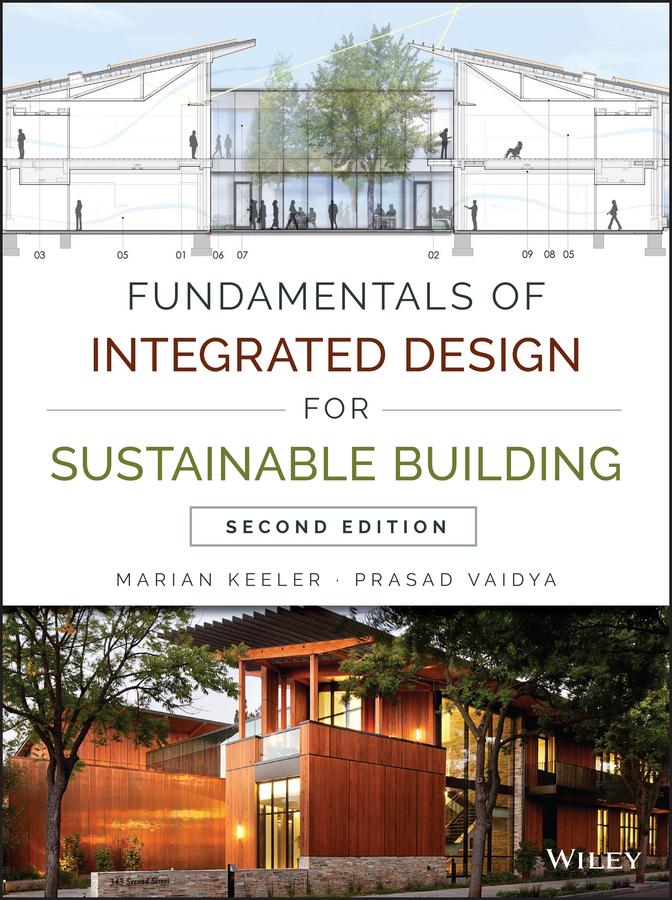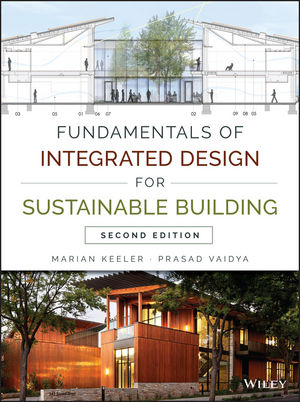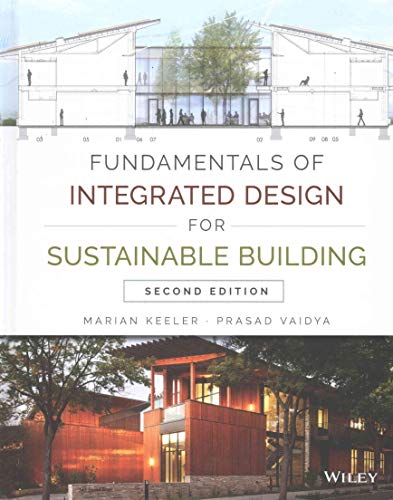
ISBN: 9781118881910
The Fully Updated, Indispensible Study of Sustainable Design Principles Fundamentals of Integrated Design for Sustainable Building is the first textbook to merge principles, theory, and p… mais…
| Indigo.ca new in stock. Custos de envio:zzgl. Versandkosten., mais custos de envio Details... |

ISBN: 9781118881910
*Fundamentals of Integrated Design for Sustainable Building* - 2. Auflage / gebundene Ausgabe für 112.99 € / Aus dem Bereich: Bücher, Kunst & Musik Medien > Bücher nein Buch (gebunden) Bü… mais…
| Hugendubel.de 1118881915. Custos de envio:Shipping in 2 weeks, , Versandkostenfrei nach Hause oder Express-Lieferung in Ihre Buchhandlung., plus verzendkosten. (EUR 7.50) Details... |

2016, ISBN: 9781118881910
Buch, Hardcover, 2nd edition, [PU: John Wiley & Sons Inc], John Wiley & Sons Inc, 2016
| lehmanns.de Custos de envio:Titel z.Zt. nicht lieferbar. (EUR 0.00) Details... |

ISBN: 9781118881910
Fundamentals of Integrated Design for Sustainable Building Hardcover Used Books, Wiley
| Knetbooks.com used in stock. Custos de envio:plus verzendkosten., mais custos de envio Details... |

2016, ISBN: 1118881915
[EAN: 9781118881910], Nieuw boek, [SC: 31.87], [PU: Wiley], In Never used condition, Books
| AbeBooks.co.uk Byrd Books, Austin, TX, U.S.A. [83414208] [Beoordeling: 5 (van 5)] NEW BOOK. Custos de envio: EUR 31.87 Details... |


Fundamentals of Integrated Design for Sustainable Building by Marian Keeler Hardcover | Indigo Chapters - nuovo livro
ISBN: 9781118881910
The Fully Updated, Indispensible Study of Sustainable Design Principles Fundamentals of Integrated Design for Sustainable Building is the first textbook to merge principles, theory, and p… mais…

Marian Keeler/ Prasad Vaidya:
Fundamentals of Integrated Design for Sustainable Building - Livro de bolsoISBN: 9781118881910
*Fundamentals of Integrated Design for Sustainable Building* - 2. Auflage / gebundene Ausgabe für 112.99 € / Aus dem Bereich: Bücher, Kunst & Musik Medien > Bücher nein Buch (gebunden) Bü… mais…

2016
ISBN: 9781118881910
Buch, Hardcover, 2nd edition, [PU: John Wiley & Sons Inc], John Wiley & Sons Inc, 2016

ISBN: 9781118881910
Fundamentals of Integrated Design for Sustainable Building Hardcover Used Books, Wiley

2016, ISBN: 1118881915
[EAN: 9781118881910], Nieuw boek, [SC: 31.87], [PU: Wiley], In Never used condition, Books
Dados bibliográficos do melhor livro correspondente
| Autor: | |
| Título: | |
| Número ISBN: |
Fundamentals of Integrated Design for Sustainable Building is the first textbook to merge principles, theory, and practice into an integrated workflow. This book introduces the technologies and processes of sustainable design and shows how to incorporate sustainable concepts at every design stage. This comprehensive primer takes an active learning approach that keeps students engaged.
This book dispenses essential information from practicing industry specialists to provide a comprehensive introduction to the future of design. This new second edition includes:
Expansive knowledge—from history and philosophy to technology and practice Fully updated international codes, like the CAL code, and current legislations Up-to-date global practices, such as the tools used for Life-Cycle Assessment Thorough coverage of critical issues such as climate change, resiliency, health, and net zero energy building Extensive design problems, research exercise, study questions, team projects, and discussion questions that get students truly involved with the materialSustainable design is a responsible, forward-thinking method for building the best structure possible in the most efficient way. Conventional resources are depleting and building professionals are thinking farther ahead. This means that sustainable design will eventually be the new standard and everyone in the field must be familiar with the concepts to stay relevant. Fundamentals of Integrated Design for Sustainable Building is the ideal primer, with complete coverage of the most up to date information.
Dados detalhados do livro - Fundamentals of Integrated Design for Sustainable Building
EAN (ISBN-13): 9781118881910
ISBN (ISBN-10): 1118881915
Livro de capa dura
Livro de bolso
Ano de publicação: 2016
Editor/Editora: WILEY
Livro na base de dados desde 2015-09-07T21:32:13-03:00 (Sao Paulo)
Página de detalhes modificada pela última vez em 2023-11-11T01:45:37-03:00 (Sao Paulo)
Número ISBN/EAN: 1118881915
Número ISBN - Ortografia alternativa:
1-118-88191-5, 978-1-118-88191-0
Ortografia alternativa e termos de pesquisa relacionados:
Autor do livro: keel, keeler, marian, prasad, vaidya
Título do livro: fundamentals, building design
Dados da editora
Autor: Marian Keeler; Prasad Vaidya
Título: Fundamentals of Integrated Design for Sustainable Building
Editora: Wiley; John Wiley & Sons
408 Páginas
Ano de publicação: 2016-06-21
Peso: 1,150 kg
Língua: Inglês
97,90 € (DE)
Not available (reason unspecified)
220mm x 281mm x 26mm
BB; Hardcover, Softcover / Kunst/Architektur; Architektur; Architecture; Architektur; Bauentwurf; Building Design; Allg. Architektur; Bauentwurf
Preface xiii Contributors xv Acknowledgments xix CHAPTER 1 The Integrated Building Design Process 1 What Is Integrated Building Design? 1 The Process 1 The Focus Areas: Energy, Resources, and Indoor Environment 6 CHAPTER 2 A History of the Environmental Movements 15 Roots 15 Grassroots Movements 17 The Industrial Revolution 19 The Modern Chemical Revolution 20 Twin Tracks of Environmentalism: Conservation and Preservation Movements 21 The Ecology Movement 24 CHAPTER 3 International Conferences and Treaties 27 The Club of Rome 30 The International Conferences 31 After Kyoto 35 CHAPTER 4 The Emergence of Green Building and Green Building Policy 39 Defining Green Building 40 The Roots of Green Building 42 Environmental Toll 43 Green Building Today44 The History of US Energy Policy 46 Green Building Codes in the United States 49 The Road to Green Codes 51 In Summary 53 CHAPTER 5 Chemicals in the Environment, Buildings, and Humans 55 Emission, Transmission, Deposition, and Immission 55 Pathways of Transmission 61 The Right to Know: Chemical Transparency 63 Green Chemistry and Building Materials 72 Rethinking Building Systems 73 Air Systems 74 CHAPTER 6 Fundamentals of Indoor Air Quality 79 Leon Alevantis, MS, PE, LEED AP Why Is Good IAQ Important? 79 Contributors to IAQ 80 Types of Indoor Pollutants 81 Pushing the Envelope for IAQ Design 84 CHAPTER 7 Indoor Environmental Quality Issues 93 What Is IEQ? 93 Other IEQ Issues 103 Benefits of Good IEQ 104 CHAPTER 8 How Buildings Use Energy 107 Energy in the Life Cycle of a Building 107 Evolution of Buildings and Its Impact on Energy Consumption 107 Operating Energy Use Patterns 110 Heat and Heat Transfer Modes 111 Climate and Weather 114 Traditional Design Response to Climate 118 Occupant Needs 118 Conclusion 123 CHAPTER 9 Reducing Energy Loads 125 Predesign: Site Selection, Building Size, and Transportation 126 Site Analysis 126 Massing and Orientation 128 Building Envelope 128 Lighting 138 Plug Loads 141 Passive Design 142 Case Study: School in Damascus, Syria 149 CHAPTER 10 Energy-Effi cient HVAC Systems 155 Central versus Decentralized Systems 156 Decentralized Systems 156 Central Heating and Cooling Systems 159 HVAC Controls 165 Domestic Hot Water 167 Thermal Zoning and Impact of Architectural Design 167 Preliminary Design Guidelines 168 CHAPTER 11 Energy Modeling and Measurement 171 Metrics for Energy 171 Site Energy and Source Energy 172 Metering, Submetering, and Benchmarking 173 Energy Modeling 176 Energy Modeling Tools 180 Using Modeling to Drive Integrated Cost Estimation 183 CHAPTER 12 Net Zero Energy and Renewable Energy Systems 187 NZE Definitions 187 On-site Renewable Energy Generation 188 NZE Technical Potential 193 NZEB Design Issues 194 NZE at Community Scale 196 Utility Grid and Distributed Generation 196 NZE in Policy 198 Case Studies 199 CHAPTER 13 Climate Change and Resilience 207 The Science 208 CHAPTER 14 How Buildings Use Resources 223 What Are Natural Resources? 223 CHAPTER 15 Materials Selection and Product Certification 239 The Benefits of Healthy Skepticism 239 Materials Have Multiple Impacts 240 The Bases for Materials Selection 240 Making Contact with Technical Staff 244 Environmental Product Declarations 244 Emissions Testing 245 Product Certification, Rating, or Label 246 Tools: Putting It Together 250 CHAPTER 16 How Built Landscapes and Buildings Contribute to Water Quality and Conservation 259 Jamie Phillips and Kevin Conger, CMG Landscape Architecture The Urban Watershed: Watershed Function 259 National Water Policy 260 Pollutants of Concern in the Landscape 261 Urban Stormwater Management: Low?]Impact Design 263 Site Design: Primary Goals 263 Preservation and Protection of Creeks, Wetlands, and Existing Vegetation 263 Treatment Control BMPs 264 Water Conservation in the Landscape 269 Water Use and Energy Use in Buildings 270 CHAPTER 17 Sustainable Neighborhoods and Communities 275 Aaron Welch, Saneta deVuono-Powell, and Matt Raimi, Raimi + Associates What Are Sustainable Communities? 275 A Brief History of Sustainable Planning 276 History of Conventional Development 276 Components of Sustainable City Planning 287 Conclusion 301 CHAPTER 18 Rating Systems and Practice Tools 303 What Is a Rating or Certification System? 303 Living Building Challenge Mission 309 The WELL Building Standard by Delos 310 Regional Systems 312 Ed Mazria and the 2030 Challenge 315 Practice Tools that Drive the Rating System 316 CHAPTER 19 Life-Cycle Assessment 321 Definitions 322 Standards and Methodology 323 Components 324 CHAPTER 20 Waste Management and the Building Industry 337 Waste Impacts 338 Waste Cycles 339 Defining Waste 340 Waste Streams 340 Hospital Waste 341 Integrated Waste Management 342 Benefits of Construction Waste Management 343 Green Demolition 344 Incineration 346 Waste to Fuel 346 Best Practices 346 Diversion 348 Design for Disassembly 348 Construction Waste Management Plans 350 Other Job?]Site Waste Strategies 350 Zero Waste 353 Glossary 357 Index 363Outros livros adicionais, que poderiam ser muito similares com este livro:
Último livro semelhante:
2901118881919 Fundamentals of Integrated Design for Sustainable Building (Marian Keeler)
- 2901118881919 Fundamentals of Integrated Design for Sustainable Building (Marian Keeler)
- 9781118882276 Fundamentals of Integrated Design for Sustainable Building (Marian Keeler, Prasad Vaidya)
- 9781118782729 Fundamentals of Integrated Design for Sustainable Building (Michael Ermann)
- 9780470152935 Fundamentals of Integrated Design for Sustainable Building: Principles and Practice (Keeler, Marian, Burke, Bill)
- [(Fundamentals of Integrated Design for Sustainable Building: Principles and Practice )] [Author: Marian Keeler] [Jun-2009] (Marian Keeler)
< Para arquivar...

